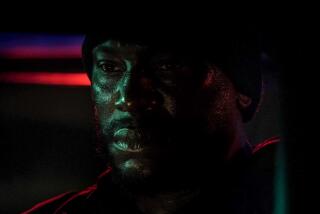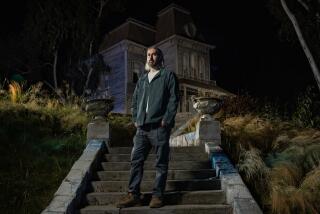Hollywood rarely did Donald Westlake justice
One of the enigmas in the long and rich career of Donald E. Westlake was that this author of more than 100 novels, many of them popular, accessible and plot-driven works of crime fiction, both grim and comic, received such a spotty handling by Hollywood.
Roughly two dozen films emerged from Westlake’s novels or involved screenplay work by the man himself. But only two -- 1967’s “Point Blank,” based on the first novel he wrote under the pseudonym Richard Stark, and Westlake’s adaptation of Jim Thompson’s “The Grifters” (1990) -- are clear standouts. Both films, oddly, were done by British directors (John Boorman and Stephen Frears, respectively) well out of the Hollywood mainstream.
“When you read the books, your superficial sense of them is that they’re totally movie-ready,” said Terrence Rafferty, a veteran film critic who’s written for the New Yorker and GQ. But adaptations of Westlake’s work, he said, range mostly from not very good to the “train wreck” that is 2001’s “What’s the Worst That Can Happen?” and the “absolutely dreadful” case of 1974’s “Bank Shot.”
Otto Penzler, Westlake’s longtime friend and publisher, calls the author’s Hollywood career “erratic.” He sees it as “mostly bad luck. There were a couple of good films, but they were mostly lousy.” Penzler has a special disdain for the 1982 Gary Coleman vehicle “Jimmy the Kid.”
The issue of Westlake’s Hollywood legacy is worth pondering now, after the novelist’s death, at age 75, of a heart attack on New Year’s Eve. Next week, the first-ever film adaptation of Westlake’s work, “Made in USA,” opens at the Nuart Theatre in West Los Angeles, more than four decades after it was made.
And that movie highlights another irony: The film, well regarded by the few who have seen it, was directed by Jean-Luc Godard, who is, of course, a Frenchman.
It makes you wonder, Why was it so hard for Hollywood to get Westlake right?
So many attempts
Westlake, who spent most of his life in and around New York City, was admired not just by noir-heads like Elmore Leonard and Quentin Tarantino, but by highbrow novelists like Ireland’s John Banville as well. Over a career that spanned five decades, he wrote all kinds of novels, including science fiction and espionage, under a host of pen names to mask his prodigiousness.
But Westlake’s major work breaks down into two main series: The comic-heist novels he wrote under his own name, featuring the luckless protagonist John Dortmunder, and the grim, austere Parker novels -- written under the pseudonym Richard Stark -- about an ultra-violent, emotionless hitman with his own rigid code of personal ethics.
“They’re so plot-driven,” said Penzler of the Parker books. “And what a great character -- there are very few professional crooks in literature who you don’t relate too but you sort of root for, because he has this kind of bizarre integrity.”
Many film adaptations of Westlake’s novels, both in the U.S. and Europe, have come from the Stark novels. The writer himself described those books, which began with 1962’s “The Hunter,” as “stripped down and bleak, no adverbs. . . . The name will be ‘Stark’ to remind me what we’re doing here.”
Godard’s “Made in USA,” which uses the Stark novel “The Jugger,” about Parker looking into the death of a safecracker, as a jumping-off point, was still close enough to the book that the film was legally tied up for decades over a permission dispute. Despite being the first Westlake adaptation, the 1966 film is only just now -- thanks to the author’s agreement -- getting an American release.
It also stands to date as perhaps the most eccentric film ever made from the novelist’s work, in part because an actress (Anna Karina) plays the ultra-macho Parker. The film follows her as she seeks answers about the death of her lover in a French-speaking Atlantic City populated by philosophical hoods and singing waifs.
According to actor László Szabó, who plays a corrupt cop in “Made in USA,” Westlake’s novel was not on the actors’ minds much during the shoot. “Jean-Luc just gave us eight to 10 pages of writing,” which the actor thinks ensured that the author would not overpower the auteur.
“It was an oddball film even for Godard,” Westlake told Variety in 2004.
That movie was followed a year later by Boorman’s “Point Blank,” which concerns Parker -- here called “Walker” -- rising virtually from the dead after being betrayed by his wife and partner. The next Stark film was the 1968 blaxploitation movie “The Split” -- appropriate since some of Stark’s earliest supporters were black men who may have responded to the protagonist’s outsider status -- starring NFL great Jim Brown.
In a filmed interview called “The Hunter,” the author pointed out that three very different actors played his antihero in the first three films -- Karina in Pop art dresses for “Made in USA,” Lee Marvin in a ‘60s suit for “Point Blank” and the rugged Brown for “The Split.”
As Westlake recalled: “A friend of mine said, ‘So far, Parker’s been played by a white guy, a black guy and a woman. I think the character lacks definition.’ ”
For many, it was Marvin who captured Parker’s style perfectly. “Lee Marvin was the perfect Westlake actor,” Rafferty said. “Impassive and a serious man.” (Boorman, oddly, claimed never to have read the novel, “The Hunter,” that his celebrated film was based on.)
It’s the role Mel Gibson played in “Payback,” the 1999 Brian Helgeland movie also based on “The Hunter,” a film that many thought made Parker (who in the film is called “Porter”) seem too sympathetic -- something that doesn’t work with this kind of amoral killer.
Westlake himself, interestingly, called Robert Duvall, who played Parker (called “Macklin”) in “The Outfit,” the 1973 adaptation of the third Stark novel, “perhaps the closest to Parker. What Lee Marvin did was a wonderful destroyed Lee Marvin. What Robert Duvall did was a wonderful, terse, taciturn Parker.”
His screenwriting
Westlake’s other series protagonist, Dortmunder, hasn’t fared much better on the big screen; the one exception being the Robert Redford-starring, William Goldman-adapted “The Hot Rock” from 1972. According to Rafferty, part of the problem is that Hollywood filmmakers were often too quick to soften the “cool, very dry, fatalistic” Westlake tone.
Penzler, who is also the editor of “The Black Lizard Big Book of Pulps,” has another theory on why adaptations of Westlake weren’t more successful.
“The screenwriter they should have hired for all these was Westlake himself. Look at what he did with ‘The Grifters.’ ”
But Westlake’s screenwriting career was a mixed success at best. He wrote the well-regarded 1987 horror film “The Stepfather,” about a homicidal suburban dad, starring “Lost’s” Terry O’Quinn. “The Grifters’ ” critical and box-office success and Westlake’s Oscar nomination for his work in the film made him popular in Hollywood, but his movie career never caught fire. He worked on the James Bond film “Tomorrow Never Dies” but did not receive screenwriting credit, and he co-wrote the script for 2005’s “Ripley Under Ground.”
The author said: “If I write a novel, I’m a god. If I write a screenplay, I’m a minor deity.”
“He was a total realist,” said Penzler, who said that Westlake loved watching movies and did not expect Hollywood to be a cakewalk. But he was not the kind of writer who liked setting his books aside for long to work on a film. “At the end of the day, he was a novelist.”
More to Read
The biggest entertainment stories
Get our big stories about Hollywood, film, television, music, arts, culture and more right in your inbox as soon as they publish.
You may occasionally receive promotional content from the Los Angeles Times.










